I want to finish up my series on Creating Incidental Teaching Opportunities in specific activities by talking about snack. I love snack–yes I love to eat snack, but I also love to use it as a teaching opportunity because it is both a highly motivating time as well as a group activity so I can embed both communication and social skills into it.
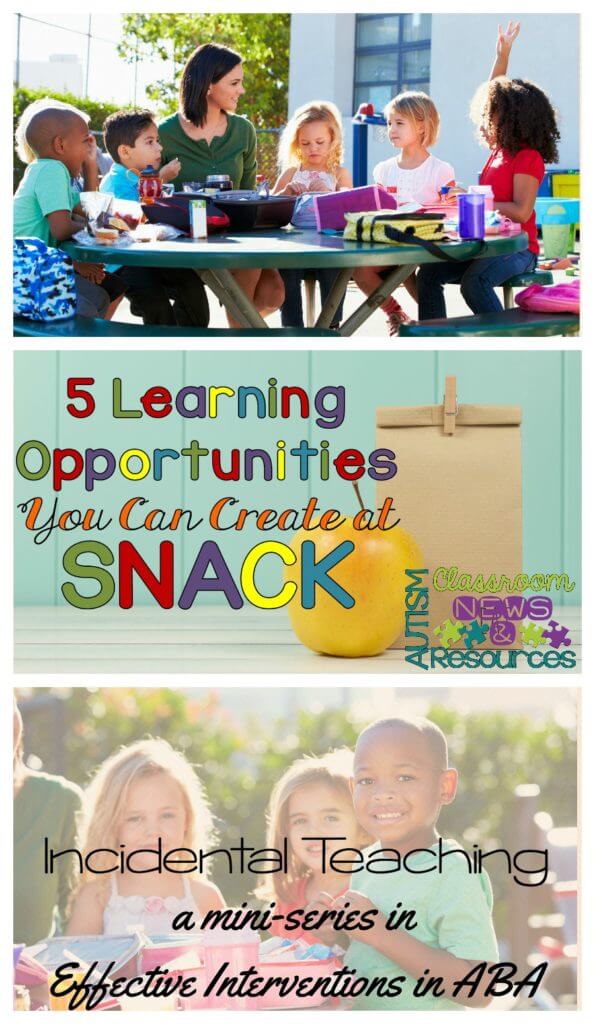 Let me start by saying that when I set up most classrooms, snack is an optional time in the sense that it isn’t required. Sometimes it’s in the morning and sometimes in the afternoon depending on the schedule. It does not take the place of lunch. If it takes place at breakfast I modify some of these strategies to make sure the kids eat their breakfast. I make this distinction because setting up opportunities using food as a motivator means that we hold the food back a little. As with all teaching, it’s about finding a balance between stretching what the student is expected to do with not overwhelming or frustrating him. So this means that he isn’t given free access. So if it takes place at breakfast, I make part (usually the first part) be a teaching time and the last part he has free access to his breakfast. And this is also why I don’t practice the same process at lunch in most situations because I don’t want to hold back lunch that the kids need to eat.
Let me start by saying that when I set up most classrooms, snack is an optional time in the sense that it isn’t required. Sometimes it’s in the morning and sometimes in the afternoon depending on the schedule. It does not take the place of lunch. If it takes place at breakfast I modify some of these strategies to make sure the kids eat their breakfast. I make this distinction because setting up opportunities using food as a motivator means that we hold the food back a little. As with all teaching, it’s about finding a balance between stretching what the student is expected to do with not overwhelming or frustrating him. So this means that he isn’t given free access. So if it takes place at breakfast, I make part (usually the first part) be a teaching time and the last part he has free access to his breakfast. And this is also why I don’t practice the same process at lunch in most situations because I don’t want to hold back lunch that the kids need to eat.
So with all that said, here are 5 skills we can target during snack by creating teaching opportunities in a naturalistic environment.
Requesting
This one is pretty obvious. Snack is a great time, because food is often motivating, for us to limit the amounts that we give so the student has to make multiple requests for his highly desired food item. Keep in mind that if he doesn’t really care for the snack food, there is limited motivation. If that is the case and you can’t change the food to something more motivating (i.e., diet, school policy, kid just doesn’t like food), then you will have to find something else that is motivating (e.g., legos) and set aside some time during the day (maybe while the other students finish snack) for making requests.
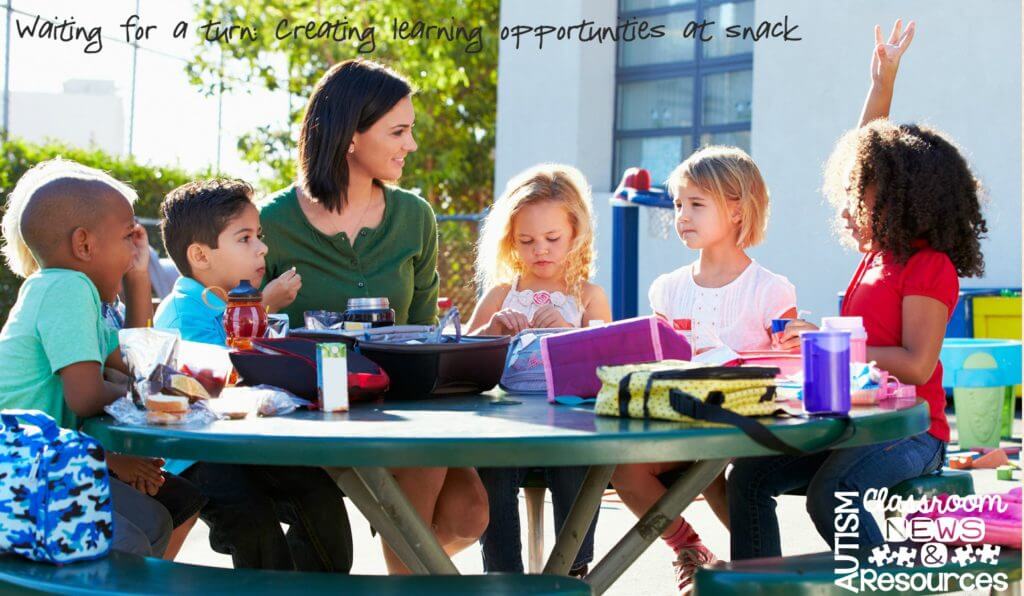 Peer-to-Peer Requests
Peer-to-Peer Requests
This is one of my favorites and not always quite as obvious. Once students are able to make requests of adults, I love to use this motivating time to build skills asking peers for things. So, have you met Snack Guy and Snack Chick? (Sorry I don’t have pictures that I can share on the internet for this activity, but there is so much cute stuff you can do with it. Have the students wear an apron and a cap, use a cardboard box with a string around their neck to have a tray like a stadium seller. You can do different modifications based on the age of the students. For older students, it might just be having a special notepad they carry and write orders on.) Also I can’t take complete credit for this concept–it is one we used at the Baudhuin Preschool when I arrived there many years ago and we’ve modified over the years for different ages.
The focus of Snack Guy and Snack Chick (or waiters and waitresses) is for the students to learn to ask peers for something they want or need and increase peer interaction. To do this the waiter has control over the food and the customers/ diners put in orders. Sometimes I make up a menu on a white board about what is available; sometimes I just put the snack items out where they can see them. If the students need PECS or visual cues or their device, I make sure the vocabulary is included on those as well. Then I teach the peer to ask each student (one at a time) what he/she wants for snack and then deliver it. In some instances I have the students learn to raise their hand or wait for the waiter to come to them and have the waiter wait for an order. However I set it up, it has to be so that the waiter has access to the food, knows to give a limited amount, and wait for a request from a peer–so the waiter may need some coaching and support to do this.
OK, it turns out I forgot how much I love this concept so I’ll be back in the near future to give you more ideas for how I set up Snack Guy and Snack Chick / Waiter and Waitress because there is so much you can do with this concept.
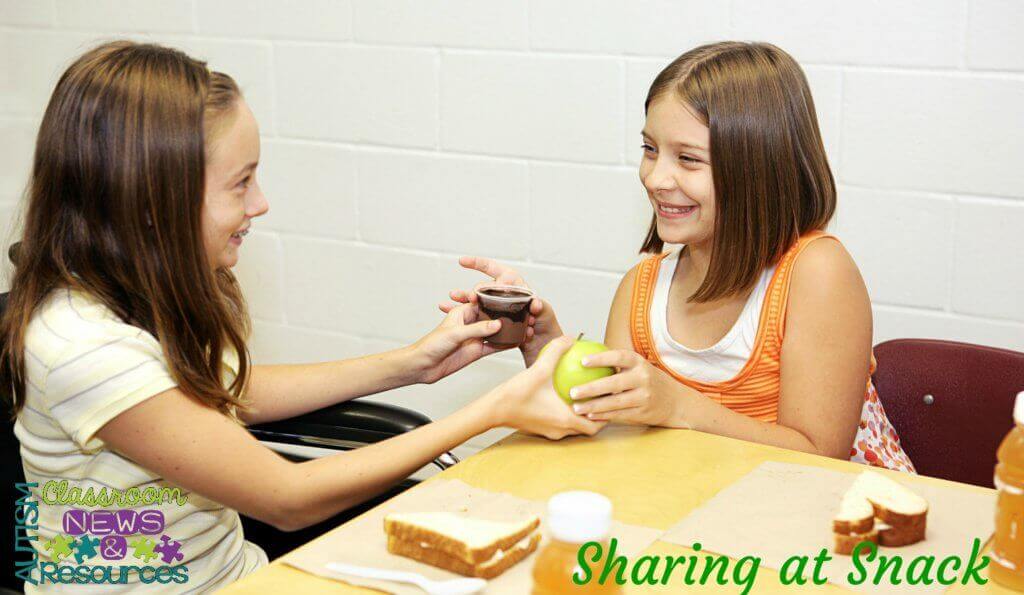 Sharing
Sharing
As long as you don’t have issues with children sharing food because of restrictive diets, sharing is a great skill to target during snack. Again, this works well if food is motivating. If not take some of the snack time when students are waiting to present them with highly desired activities they can practice sharing. Just like with the art example in one of the last posts, limit the access to the items being shared and encourage the students to trade or share their food. If one student is reaching for another’s food, that’s an opportunity to teach him to ask and the other student to share. If you know that one of the students has a highly desired item, that’s a good opportunity to encourage sharing as well. Model sharing of your own “snack” as well to encourage it.
Counting
This is a pretty common concept in snack–having students count their snack. You can also have them request their snack by specifying how many of something they want (e.g., “I want 3 Skittles please.”). To set up the opportunity, just block their access to the snack food and allow access once they have counted. If you don’t get a response, count with them and see if they will count along.
Money Exchange
Snack is a terrific time for students to learn about buying things, counting money and getting change. Set up snack so there is a price list–or just put the snack items each on a post-it with a price on it as a price tag. Give the students a specific amount of money and have them purchase their snack. You can even set one of the students up to be the cashier the students make the purchase from, to increase peer-to-peer interaction. Students then choose the food they want, determine if they have enough money to make the purchase, and get change if needed. You can also use templates set up for students to use if they aren’t able to determine how much money is needed yet (e.g., price something at 75 cents and put a card with 3 quarters on it they can match). You can also use the next dollar strategy in this activity to practice that. Again, I got myself excited about this topic so I will be back in the near future to talk about how I have set this up (with pictures) in classrooms.
In all of these scenarios, you are holding back the reinforcer, waiting for a response, and reinforcing with a natural reinforcer. You also have to make sure that you are creating multiple opportunities to practice the skill. In general, I suggest to staff that they try to get at least 5 opportunities for a skill built into the activity so the student has sufficient practice.
I’ll be back this weekend with a summary post and a free set of skill cards to post in your classroom for these 5 activities to help staff know what skills are being targeted in each area.
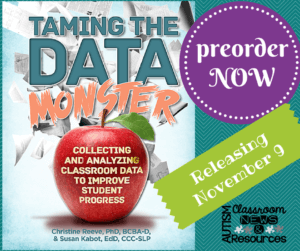
In the meantime I’m incredibly excited to tell you that our Taming the Data Monster book is now available for pre-order on AAPC Publishing. I’ll write more about this book when it is released, but I am really, really excited for you to see it! It will have access to data sheets and forms as well as explanations and suggestions for how to both implement data collection and data analysis in the classroom. Click on the picture above to check it out!
Stay tuned as well because I will be starting a book club around the book using a Facebook group…if this is of interest to you, please drop me a line and let me know what time frame will be best for you (not sure if we should wait until after the holidays)!
Until next time,

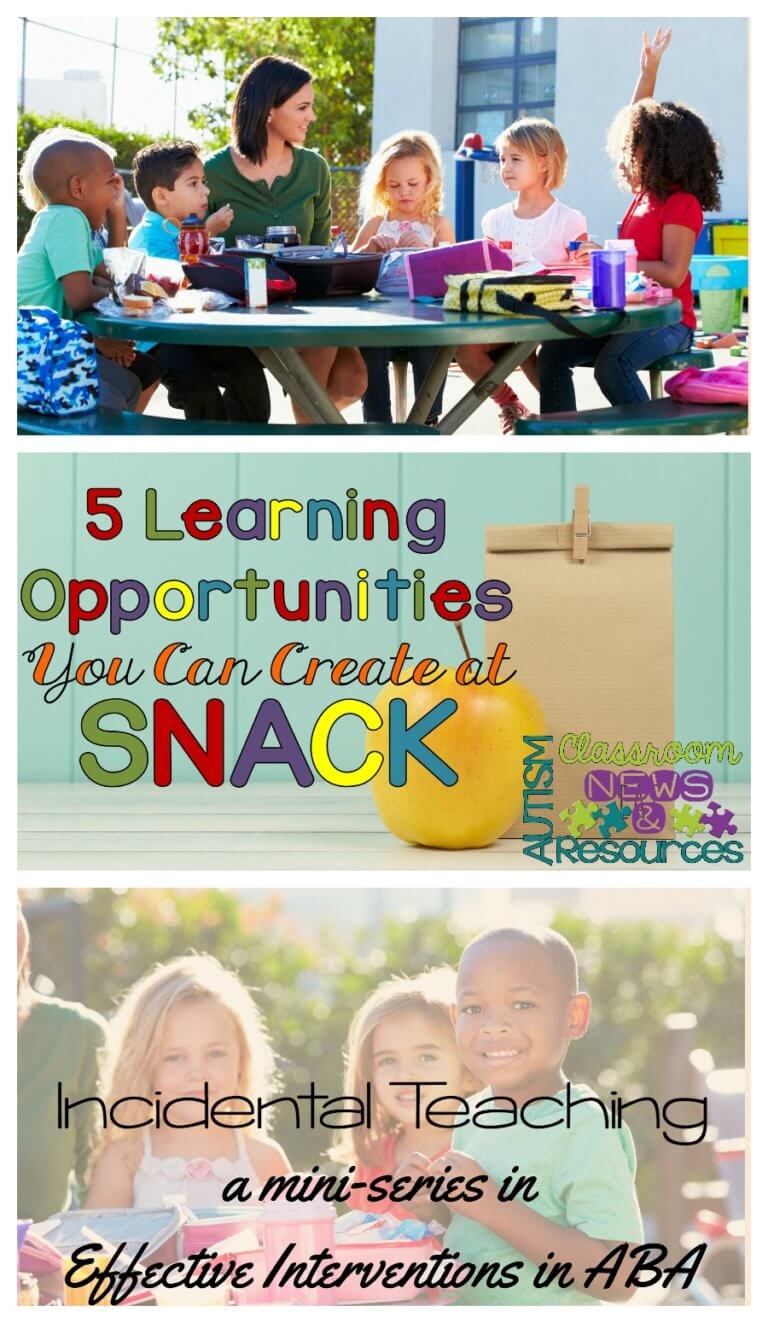



![Summer resources to help survive the end of the year in special education [picture-interactive books with summer themes]](https://autismclassroomresources.com/wp-content/uploads/2018/05/SUMMER-RESOURCES-ROUNDUP-FEATURE-8528-768x768.jpg)

